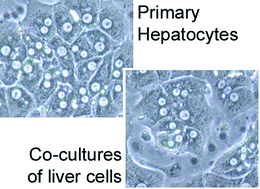In vitro models for liver toxicity testing
Abstract
Over the years, various liver-derived in vitro model systems have been developed to enable investigation of the potential adverse effects of chemicals and

Maintenance work is planned for Wednesday 1st May 2024 from 9:00am to 11:00am (BST).
During this time, the performance of our website may be affected - searches may run slowly and some pages may be temporarily unavailable. If this happens, please try refreshing your web browser or try waiting two to three minutes before trying again.
We apologise for any inconvenience this might cause and thank you for your patience.
* Corresponding authors
a
Department of Environmental Sciences and Engineering, University of North Carolina, Chapel Hill, NC 27599, USA
E-mail:
iir@unc.edu
Tel: +1-919-843-2596
b The Hamner Institutes for Health Sciences, 6 Davis Drive, Research Triangle Park, NC 27709, USA
c Department of Biological and Mechanical Engineering, Massachusetts Institute of Technology, 77 Massachusetts Avenue, Cambridge, MA 02139, USA
Over the years, various liver-derived in vitro model systems have been developed to enable investigation of the potential adverse effects of chemicals and

 Please wait while we load your content...
Something went wrong. Try again?
Please wait while we load your content...
Something went wrong. Try again?
 Fetching data from CrossRef.
Fetching data from CrossRef.
This may take some time to load.
Loading related content
